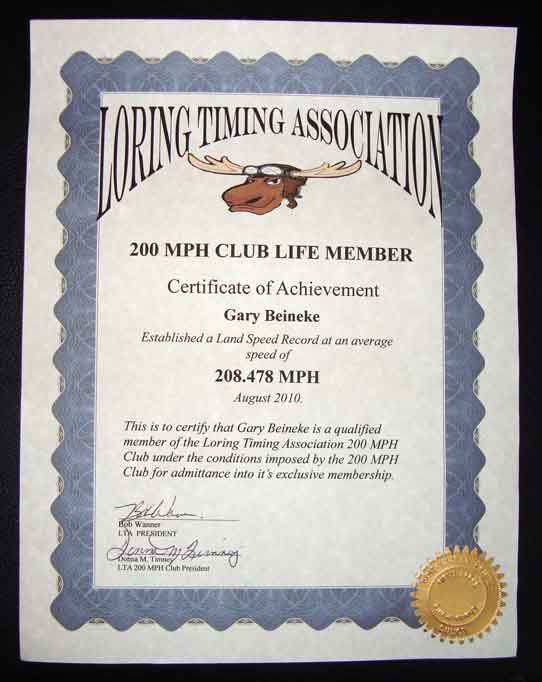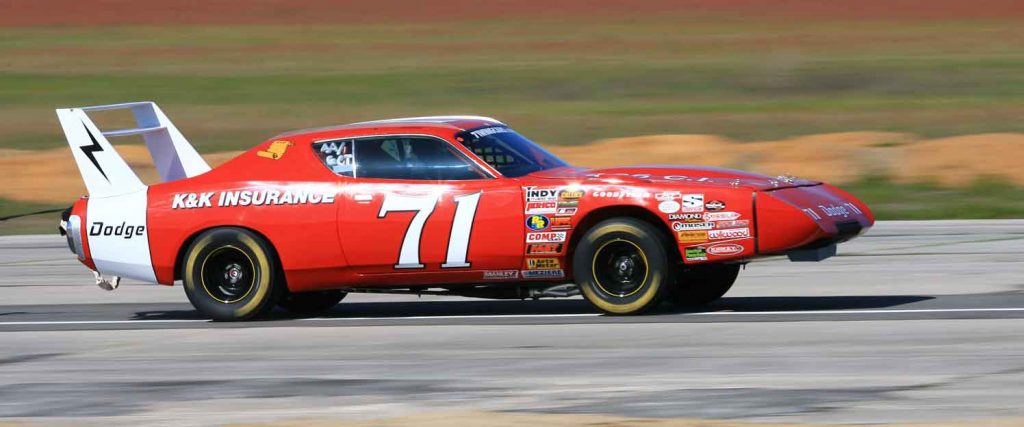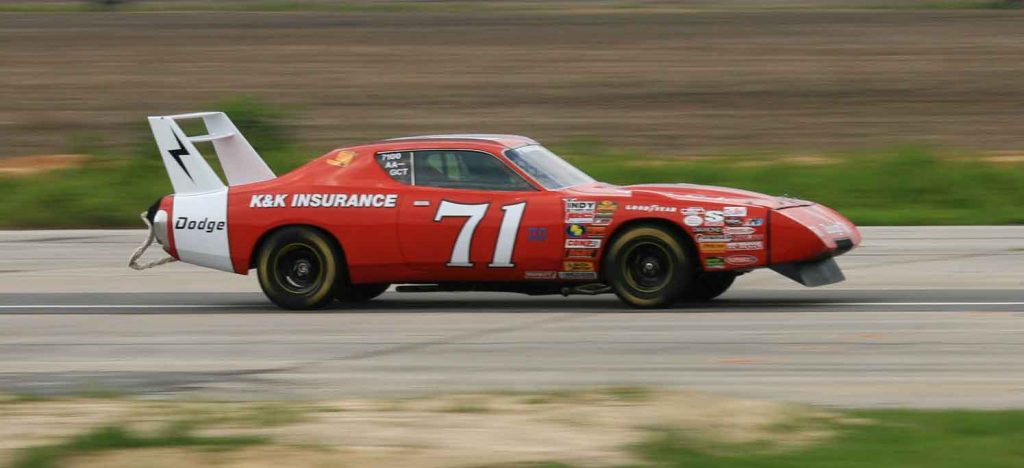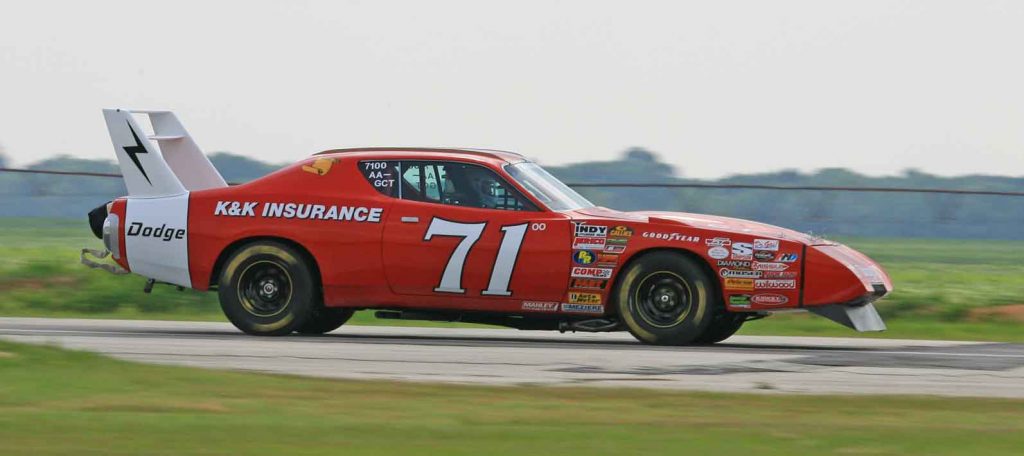200 MPH Club
You get a hat.
By Cliff Gromer Photos by TheBruntBros
The G-Whiz Beinekes’ ass-kicking, record-setting K&K-clone ’71 Hemi Daytona.
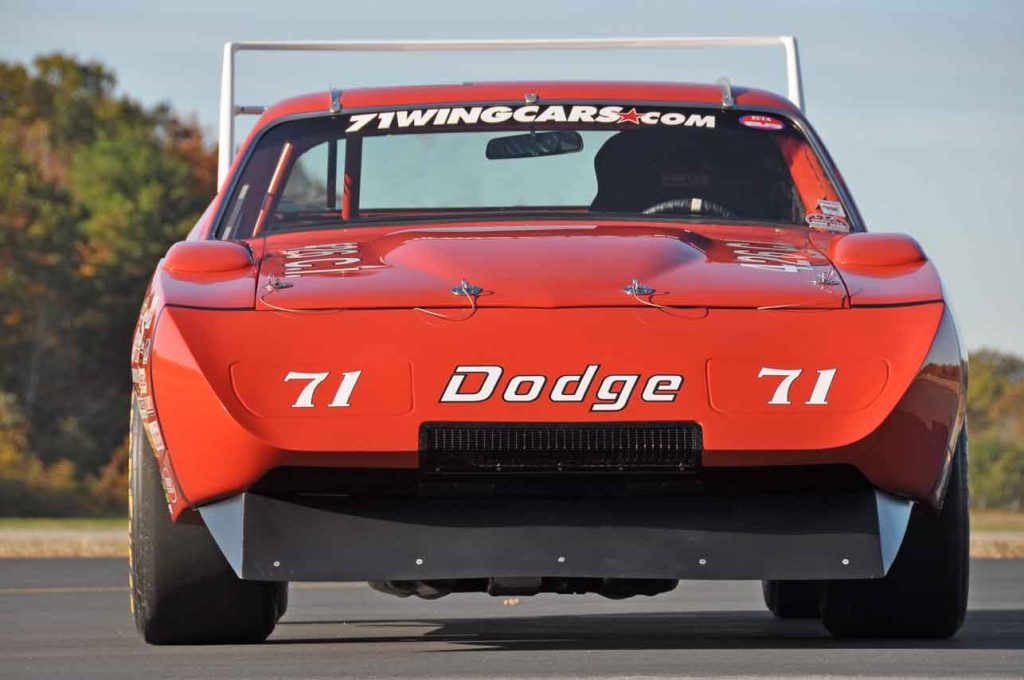
1971 K&K Hemi Daytona is number 7 in Gary and Pam Beineke’s stable of ’71 G-whizzers. This one, however, is an all-out race car built specifically for 200+ MPH in the standing mile and Bonneville.
Background
Having already aero tested the F-Series (1970) Charger Daytona, Chrysler, once again, called upon its chief aerodynamicist, Gary Romberg, to test the new G-Series Charger and Road Runner bodies (1971 model year) for aerodynamic effectiveness and see what aero components would make them as competitive or better than the earlier Daytona and Super Bird. These tests were secretly conducted at the Wichita State University’s wind tunnel. Due to the tunnel’s size, 3/8th scale models of the new bodies were used. Romberg and his team began testing in January of 1970 and finished 3-4 months later. They tested practically every conceivable wing, spoiler, and nose, including both a bi-wing and tri-wing, and even tested the proposed production rear window louvers. In the end, they wrote a 400+ page report complete with engineered drawings, photos, and conclusions.
The report had numerous graphs, wing configurations, drawings for the backlight, different spoilers, etc. Most even had had blueprints (in 3/8 scale). One proposal was the bi-wing aimed to generate enough downforce because of the turbulence that was coming off the backlight. What Romberg wanted to see was a fastback or semi-fastback like the ’69 Daytona, but Chrysler design said were not doing that. “We’re having both Plymouth and Dodge share the same backlight.” They tried rear window louvers to see if that would help reduce the turbulence, but it didn’t work. So they put both wing blades up high in the clean air to overcome lift from the turbulent air.

’71 Charger body uses fiberglass fenders that bond to ’71 Daytona nose cone. Roof rails are LSR requirements but probably don’t do much for stability in light of the huge bi-wing. Quarters are AMD’s and were widened both fore and aft of the rear wheel by 4.5 “for that old school look. Doors are stock ‘71-‘72.
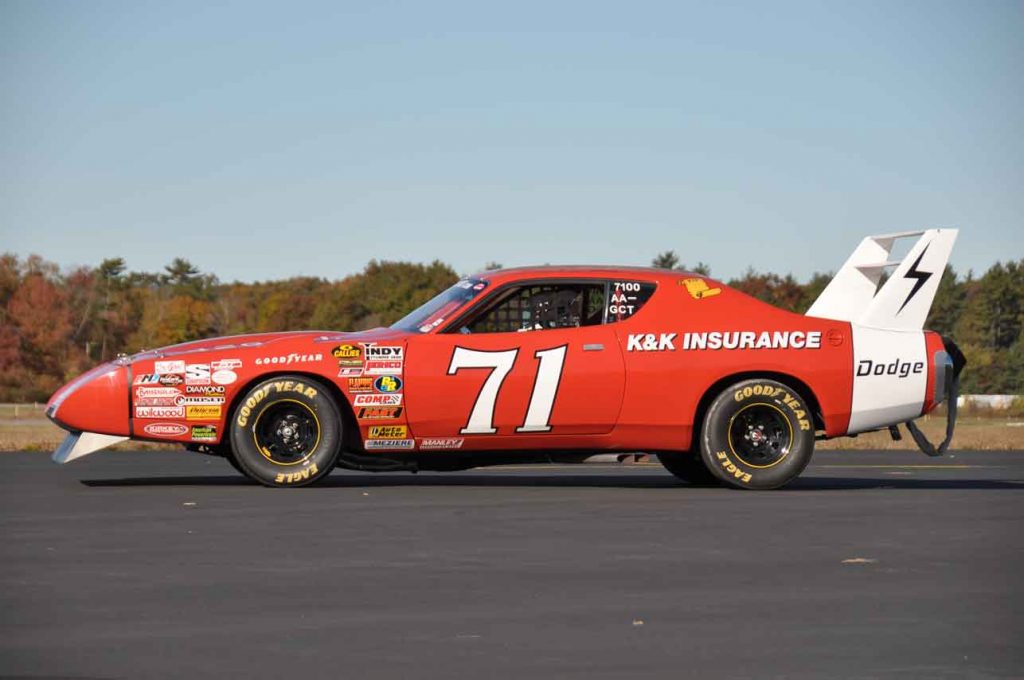
Potential top speed with 2.76 gears is 237 MPH. Car would need a quick-change rear for numerically lower ratio for a shot at the 293 MPH Bonneville class record. Door net, not window net, is required by the rules and was custom made to fit the unique opening of the ‘71 Charger. Brakes and steering are manual.
Just as these tests were being concluded, Bill France, president of NASCAR sanctioned the wing cars out of competition, with a 305-cube maximum for any aero car. Chrysler had some success with the 305 wing cars, but the writing was on the wall. So, the report, which cost Chrysler a reported $70,000, was tossed in the trash with only a few copies surviving today.
As a side note, according to Romberg, Chrysler also tested E-bodies in the wind tunnel. The designers asked Romberg what could be done to help the cars’ aero numbers. He said the first thing was to flush the grille area. Styling said no, and asked him what if they added a rear wing? He explained that this would only exacerbate the nose lift by pushing down on the rear. They said, what if we use rear window louvers? He said, you can put venetian blinds on it if you want, but you can’t get past that cavernous grille.
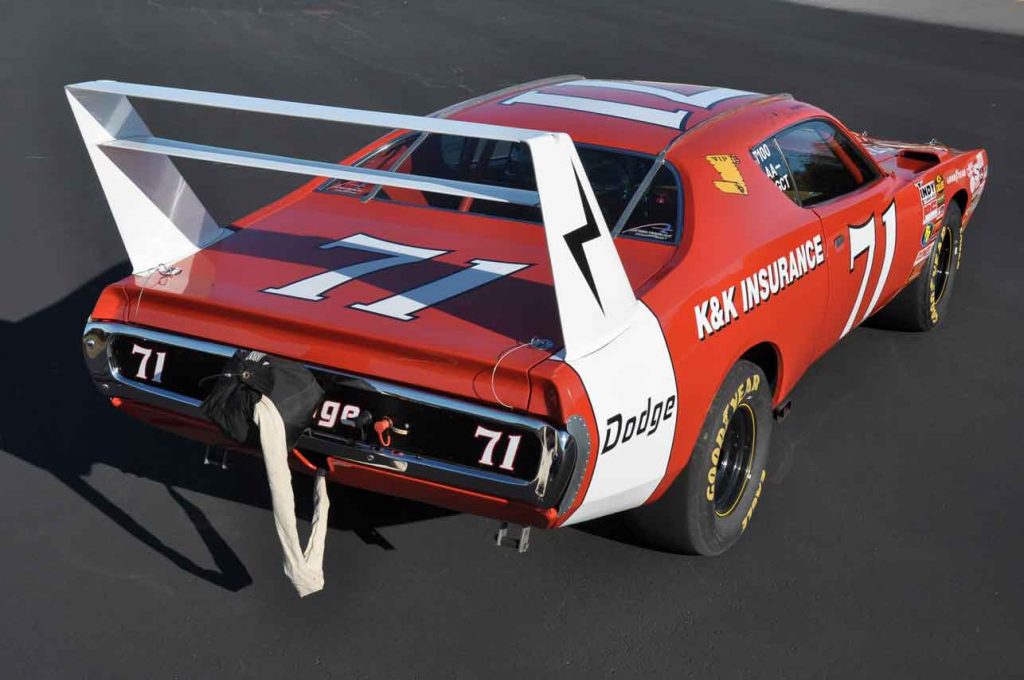

High wing was necessary to ride in the clean air above turbulence created by stock backlight. Wing is TIG welded aluminum with steel support bracing to the trunk floor. The rear bumper was narrowed to flush the ends The bumper filler panel is aluminum, mounted by TIG welding tabs to correspond to the factory taillight housings and bolted in. The panel was drilled and riveted for the old school look. Rear valance is AMD’s new piece which was widened due to the rear quarter widening. Stroud parachute: better than drugs when that thing hits. Takes the thought of what an idiot you are doing this to “that was cool, let’s do it again.”
The Idea
In 2002, Pam and Gary Beineke (www.71Wingcars.com) built the first street version of the ‘71 Daytona, followed by the ‘71 Super Bird. They kept them as accurate to the prescribed optimum configuration in the G-Series report; admittedly with styling being one of the factors. Years later, after completing other projects, they decided to do the car they wanted to do for years–the K&K Insurance Daytona…their way: a “what-if” next-generation tribute Daytona to Bobby Isaac’s Bonneville record-setting car. Not as a street car, but as an actual race car that would be run in land speed racing (LSR) events at Maxton, N.C., Loring, Maine, and Bonneville itself. A car that would go 200 MPH
Foreplay
The project began in spring, 2009 with a ’71 Charger body. The Beinekes joined the East Coast Timing Assoc. and Southern California Timing Assoc. so their build would conform to all the LSR safety regs and rules while still maintaining an outward appearance to the K&K Daytona. Before they got too deep into the build, Pam and Gary flew down to Maxton (the old Maxton Air Force Base in NC where they run a standing mile. It’s obviously more difficult to hit 200 MPH in one mile from a dead stop than at, say Bonneville where you have much greater distance, plus a running start. The duo soaked up all the info they could—what equipment was being used, how much power they would need to guarantee200 in their 4000-lb car, what trans would hold up, what gear ratios to run, etc. Keith Turk—a multi record holder in just about every land speed event in the country, and a co-runner of the East Coast Timing Assoc. told them they’d need around 1000 HP. He also suggested a quick-change rear. But the Beinekes wanted the outward appearance of the Isaac car which ran an 8-3/4” rear. Which meant they were stuck with a 2.76 ratio. Their 8-3/4 came from Moser—a new casting developed for the Drag Pak Challenger. Moser modified it to fit their Charger.


Indy’s all-aluminum 588-inch Maxx Legend Hemi dyno’d 980 HP @ 6500 and 853 lb.-ft. tq @ 5200. Oiling uses a Missile dry sump system. Mill packs the punch of a drag engine with the durability and reliability of a NASCAR Cup car.
Biting the Bullet
For their power, Pam and Gary paid a visit to Indy Cylinder Head. What they needed was an engine that would deliver the punch of an upper-class drag racer with the durability of a NASCAR Cup engine. The Charger would run wide open throttle from 45-seconds to a minute at smaller events like Maxton and Loring, and 2-2.5 minutes at Bonneville. Indy went to the drawing board and came up with a package based on an aluminum block—not for weight savings, as front end weight was a plus to foil lift, but for reparability as opposed to iron. Indy’s 588-inch Maxx Legend Hemi would do the job with plenty in reserve so it wasn’t running on the ragged edge. Final dyno figures with a Dr. Gas exhaust (used on Cup cars) was 980 HP @ 6500 and 853 lb.-ft. tq @ 5200. Shifting at 7300 kept the Hemi in its sweet spot.
Feeding the beast is a 2000 cfm FAST throttle body with XFI injection fitted with 83 lb./hr. injectors and triggered by FAST’s dual sync distributor. This gives both crank and cam signal to the ECU without the need for a crank or cam sensor. All timing is controlled by the ECU and adjustable via laptop. Rich Nedbal at www.Fastmanefi.com helped with the tune. Fuel injection may detract from the “old school” look, but, aside from the fuel rails, it’s hard to notice with the air cleaner in place. Unlike drags where you can sort things out on multiple passes, You only get a limited number of runs in Land Speed, so you need to have your fuel and spark curves optimized pretty much out of the box. The alloy Hemi is backed by a 5-speed Jerico.

The aluminum air cleaner is hand made, and set up to take advantage of the high pressure located at the cowl and for the old school NASCAR look. It has a K&N style filter at the cowl opening.
Trials and Errors
According to indications in Romberg’s report, wind tunnel numbers on the scale-model B-bodies showed the front end generating more downforce than the rear, which is why they went to the bi-wing. Gary fabbed a production style ’69- Daytona/ Super Bird spoiler out of 1/8” aluminum, figuring he could remove it in case of excessive downforce. They had planned to hit the Aerodyne wind tunnel before the first Maxton event in April, but they ran out of time.
Maxton was a whirlwind of activity. Gary and Pam’s goal was for each of them to pilot their totally untested machine to 200 MPH in the course of the 2-day event and then go home.
“What class are you running in?”
“No class, we just want time.”
“You gotta have a class. We’ll put you in Circle Track AA.”
Anything over 500 cubes is AA. And the officials didn’t see any advantage the Daytona had over production-body Chargers and Road Runners. In order to qualify for a class there had to have been 500 copies of the model produced. Unfortunately, there were only two ’71 Daytonas—both built by Gary and Pam. So, rather than have the B’s shoot back to MA, roll up their sleeves and crank out 498 more copies ( a tall order, to be sure), the officials gave them a pass.
Now you don’t just jump in a car push the pedal into the water pump and hit the magic number. You gotta be licensed to go that fast. You make three runs—125, 150 and 175 (have to pull the ‘chute on the last run) . After that, it depends on how much cojones you have.
Gary made his licensing runs on Saturday, figuring to shoot for 200 on Sunday. If you crack 200 and also break the record in your class (which was 205 in Gary’s class), you get a “200 Mile Per Hour Club” hat. The hat from each venue is a different color (hey, collect ‘em all). Gary’s last run was a 181. The Daytona felt light and a little skittish. Since Gary had never driven that fast, he thought that’s how a car is supposed to feel at those speeds. That’s until he was given a photo of his car in the timing traps—with the nose sky high. Obviously, there was a serious lift problem, and Gary figured it was time to go home and make some changes.

Feeding chores are handled by a 2000 CFM FAST throttle body with XFI injection.
Air Fare
Working from photos of the Bobby Isaacs K&K Daytona that ran on the ovals, Gary duplicated what he saw in a larger spoiler with about four times the area as the stocker. In May, it was back to Maxton for another try—but not before a visit to the Aerodyne wind tunnel. A Chrysler legend shows up—Gary Romberg. In the conversation that followed, Gary asked Romberg about “form following function” back in the day. The way Romberg described it; when he was at Boeing, there were 300 aerodynamicists to 5 stylists; at Chrysler, 300 stylist to 5 aerodynamicists. As a result, each time they’d come up with a solution to an aero problem, Styling would say no.
With a completed, painted car, there’s not a whole bunch you can do to improve aero numbers (address the lift problem) other than tape up grilles, change spoiler size, wing angle or body rake. For the wind tunnel run or “blow,” you dial in the intended speed, and the computer gives you lift (pos or neg) at each end of the car, plus the horsepower needed to overcome drag. Since the class record at Maxton was 205 MPH, Gary plugged in 206. The results were astounding.
With the original spoiler, the computer showed a whopping 683 lbs./in2 lift up front with 100 lbs./in2 downforce at the rear. Swapping to the larger spoiler that Gary was going to run reduced front end lift to 236 lbs./in2. Romberg said to move the spoiler 3” forward Gary said it would look like crap. Romberg said it was like old times, butting heads with the stylists. “JUST MOVE IT!” The numbers told the story: 50 lbs./in2 downforce up front, same 100 in the rear. The corresponding horsepower needed to overcome drag in each configuration was 651, 569 and 553—that’s 98 “free” HP for a wind tunnel rental cost of less than $800. Such a deal!
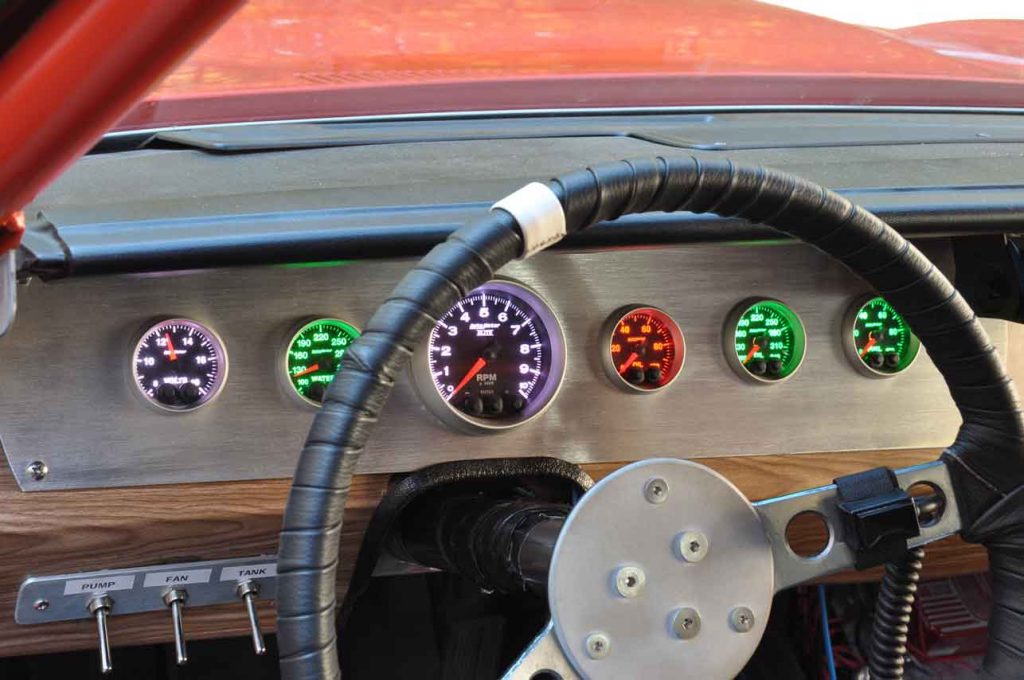
Autometer’s new Elite series NASCAR electric gauges recalibrate each and every time they are powered up. They also have hi and low warning lights .The tach has an early shift warning light, shift light and redline flashing light. All are user-programmable for color and limits. The steering wheel is a stock Challenger wheel and is wrapped with vinyl to give it the old school electric tape wrap without the sticky mess.
Main Events
Maxton, May 2010: the large spoiler is in the original position, as it has to be recontoured back at the shop to fit the new forward position on the nose (it was just taped in place in the wind tunnel.) The car handles so much easier at top speed. Gary gets in two runs at 190 MPH.
Maxton, June 2010: the spoiler is now 3 in. forward and the rear is raised 2 in. for more rake. There’s a heat index of 111 degrees. Gary makes three passes with his foot on the floor in 4th gear (1:1). He can’t break past 193 MPH. Maybe a fuel problem? At least Pam can get in a couple of licensing runs. Back at the shop he finds he’s forgotten to swap in the 8-grand rev limiter chip in place of the 7-grand one installed to protect the engine. The scene closes to the sound of Gary’s head banging against the wall.
Loring, July 31-Aug 1, 2010. Loring, Maine is a standing 1.5-mile course, and the event is held only once a year. Gary stays in 4th and hits the mile at 205. He maintains the same rpm to the end of the course to get an idea of what his Maxton time would be. On the second run, Gary hits the mile marker at a faster speed and bangs 5th. The shift is too early and the power noses over. Still, he chalks up a 208.5—a speed that resets the record in his class and earns him his hat! The Daytona now is so stable, that Gary can drive it one-handed as easily as driving down the highway at 55 (hey, where’s the cell phone?)

Interior gizmos include ‘chute release lever, dual fire suppression pullers and nifty switchbox.
Roundy-Round
Then its off to Darlington for the Historic Race Festival and some fun 100+ MPH oval laps. Gary and Pam unload the Daytona and push it back into a garage stall in paddock area. The first person to walk up to the car is Charlie Glotzbach. He gives it a long once over, then asks, “How fast did you go?”
“I’ve had it at 208.”
Charlie chuckles. “I did 243 at the Chrysler Proving Grounds.” Charlie offers some tips on tire staggering and front end geometry for running Darlington.
The Daytona’s next visitor is Cotton Owens. He knows he’s looking at the next generation “needle nose” car (as he referred to them) that never came about. Cotton talked about the 305-cube limitation placed on the needle nose cars. He says that even with the displacement handicap, the ’69 and ’70 needle nose cars should have won more races. He figured drivers[that] weren’t used to the way these cars handled…either that or they didn’t have the cojones to push them hard enough.

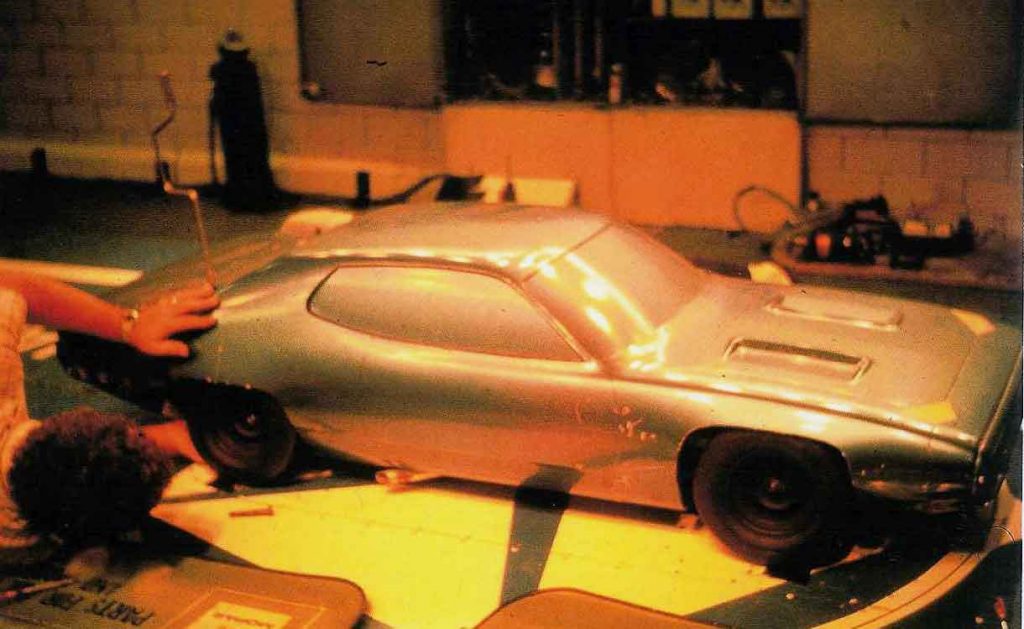

Chrysler aeroman Gary Romberg testing the 3/8th-scale Charger model in the Witchita State University wind tunnel 40 years ago, and today at the Aerodyn wind tunnel working with Gary on the K&K Daytona. Talk about laying down on the job.
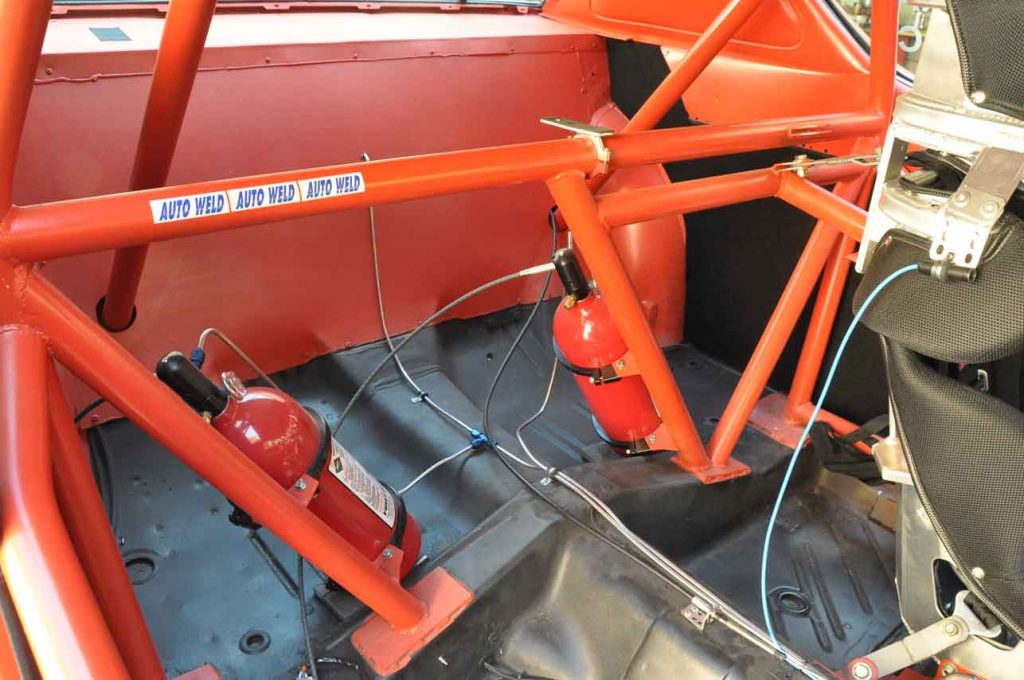
Auto Weld supplied pre-bent bars that made fabbing the beefy 6-point cage a little easier.
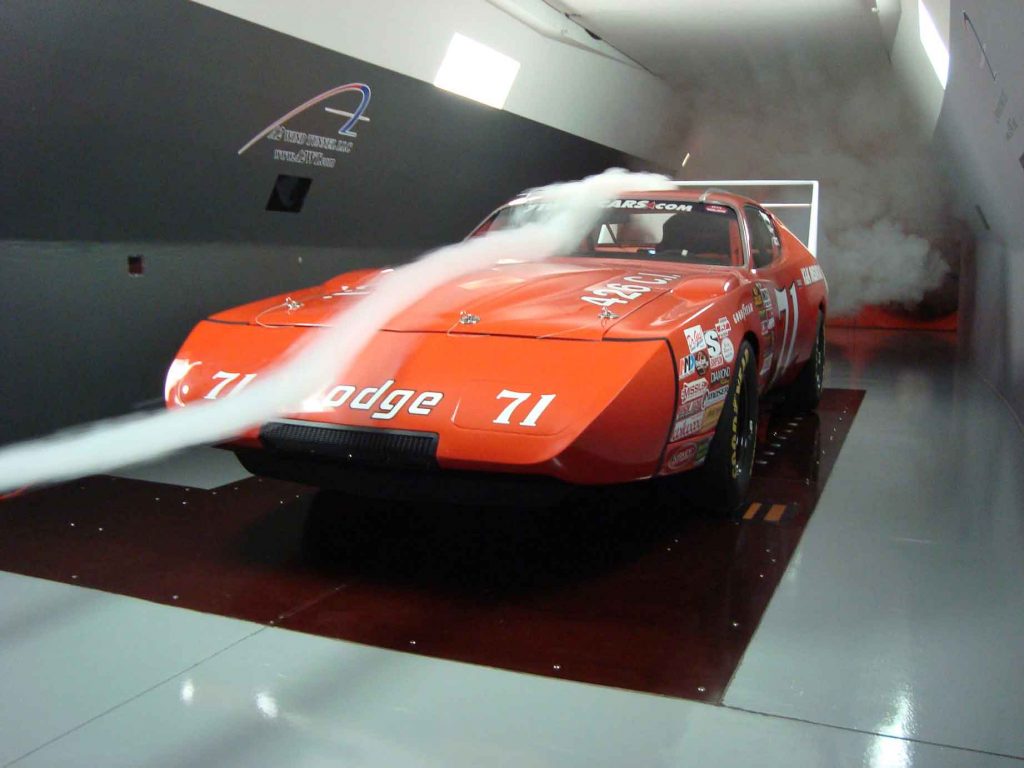
Blowing smoke in the wind tunnel shows smooth air (minimum drag) flowing over the body.
Down the Road
So, what’s next for the ’71 K&K Daytona? So far, the car has run like a clock. As of this writing, Maxton is coming up at the end of October. There are plans to run at the Bonneville World Finals in Sept. 2011—40 years almost to the day of Bobby Isaac’s- record breaking runs (he set 28 World Speed records—some of which still stand today) at Bonneville in Sept ’71 Since Bonneville times the flying mile only, G&P’s plan, at a minimum, is to match Bobby’s flying mile record of 216.9mph. On paper, Gary and Pam’s car has a top speed of 237 MPH at (7000 rpm in 5th—a 0.90:1 overdrive.) Too bad a higher gear (lower numeric) wasn’t available for their 8 ¾. ‘Course, they can always go to a quick-change rear.

Aluminum plate on right-side interior lower firewall mounts MSD’s 40th anniversary 6AL ignition box, starter solenoid, fuse panel and FAST ECU. Gary says it makes for an old-school NASCAR look.
The Bonneville folks say that the K&K Daytona tentatively qualifies for Competition Coupe class. The record in AA/CC is 293+ MPH. While the red Bonneville hat is the most sought after of them all, maybe the Beinekes had better bring their own.

Undercar shows TTI headers, Charlie’s oil pan with Missile’s dry sump oiling system and Jerico 5-speed trans.
SPECIFICATIONS
Engine specs:
Indy Cylinder Head’s 588 cubic-inch all-aluminum Indy Maxx Legend Hemi
Callies Magnum crank
Manley Pro Series billet steel rods
Diamond custom 12:1 pistons
Total Seal gapless rings
Comp Cams solid roller with their new Elite roller lifters
FAST EFI fuel injection, electric pump kit, and datalogger
Meziere electric reverse -low 55 GPM water pump
Meziere electric accessory external water pump
Missile Enterprises dry sump oil pump
Peterson oil tank
Charlies custom oil pan
Glenray Radiators custom 959 Hemi radiator
TTI headers
Dr. Gas boom tube and NASCAR X-pipe exhaust
Manton push rods
Flexalite electric fan
Firecore wires and coil
Rich Nedbal/FASTMAN EFI injection tune
Driveline
Jerico 5-speed transmission
American Powertrain, Science Friction dual-clutch assembly & flywheel,
Quicktime SFI bellhousing
PST 4-inch aluminum driveshaft
Moser’s 8-¾” replacement housing, axles, center w/2.76 gears and Detroit Trutrac
Brakes/Suspension
Wilwood 4-wheel disc, 4-piston aluminum calipers, master and prop valve
RMS upper contol arms, strut rods, shocks
Performance Suspension Components joints and sway bars
Mancini Racing .96 torsion bars, HD rear leafs, alternator, pinion snubber, starter, driveshaft loop
Aero wheels 15 X 10” (because the NASCAR rubber only comes in 15”)
DMI Doty manufacturing billet aluminum alternator brackets
Right Stuff stainless brake lines
Misc.
Autometer Elite series gauges
Racing Radio communication
Firefox dual fire suppression system
